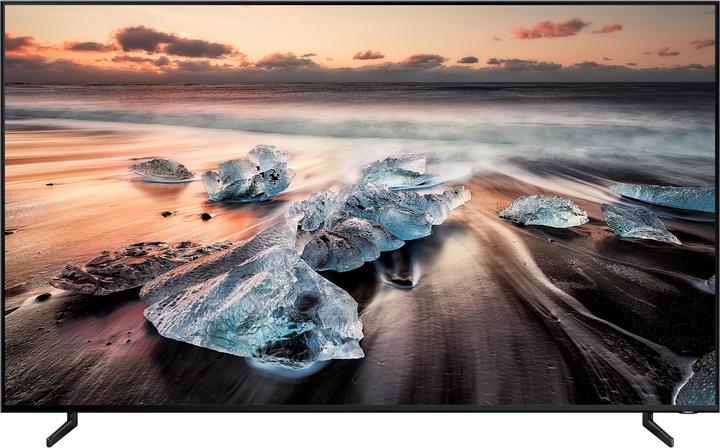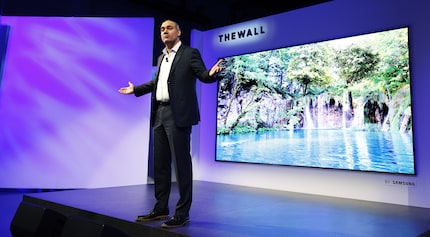

Pixels: the folly of grandeur
There's nothing better for marketing than innovation. So manufacturers regularly launch new products, whether or not they really add anything. Like 8K TVs.
The first 8K home cinema TV was released last October. Built by Samsung, it goes by the sweet name of Q900R. Its price isn't completely unreasonable. In any case, compared with OLED TVs of 75 inches or more. The latter are so expensive that Samsung's sweet pixel madness would almost pass for a bargain.
But my enthusiasm has its limits. No, it's not because of the poor picture quality. Quite the contrary. Last summer, I was able to test Samsung's flagship QLED TV, the Q9FN. A good TV that had no reason to be ashamed of the OLED competition. One thing is clear, Samsung knows how to make good TVs.
What makes me sceptical is rather the 8K definition, or what should actually be called UHD-2. As things stand, there's no point.
Why 8K is useless
An 8K TV, i.e. UHD-2, has 7680 pixels per row and 4320 pixels per column. So, in total, we get 33,177,600 pixels. That's four times more than a UHD TV and 16 times more than the full HD found on Blu-rays.
The minimum standback distance
If you want to take full advantage of 8K, you're going to have to sit very close to the TV. It's either that or a TV bigger than most living room walls. Either way, you'll barely be able to tell the difference between 4K and 8K.
Let me give you an example: if you sit 2.5 metres away from the screen, you'd need a 227-inch TV, i.e. a diagonal of 5.77 metres, to get the full 8K experience. You can find the formulas for your calculations here:
Pixel density vs colour rendering
As you've seen: pixel density is only of interest when you're sitting incredibly close to the screen or own a TV whose size rivals a cinema screen. What's much more important for picture quality is contrast and colour rendering, or HDR. This allows you to see more detail in the darker and lighter parts of the image. Like the structure of a wall in a dark, rainy alleyway, for example, or the grains of sand and dunes in a sun-drenched desert.
Lack of content and bandwidth
What good is an 8K screen when you don't have the right content to stream? Samsung makes up for it with an upscaling AI that it has equipped the Q900R with. It's even supposed to be able to scale full HD content so that you can view it on your 8K screen. In fact, the missing pixels are added to increase the total number of pixels. Artificial intelligence is used to interpret the result and improve it by [consulting] (/page/samsung-q900r-ai-upscaling-erklaert-8784) a database in South Korea.
Only thing is, the more you interpolate, that's what we call extrapolation, the further the image moves away from the real quality of the original content. In fact, the TV set's interpretation will never provide us with the best image quality.
Finally, it's the bandwidth required for data transmission that finishes off 8K TVs: content with such high definition generates an unimaginable amount of data. A quantity of data that has to be transferred to your TV from a database.
Google's tests with 8K content on Youtube required up to 45-50 megabits/s of bandwidth. The tests from Japanese TV channel NHK, which will be rebroadcasting the Tokyo 2020 Olympics in 8K, revealed that transfer rates of 80-100 Mbit/s would be required. By way of comparison, according to the Akamai report on connectivity, Switzerland surfs at an average speed of 21.7 Mbit/s, ranking 5th in the world.
In other words, the infrastructure for the transfer rates and bandwidth needed to handle the data volumes of 8K are only available in a small minority of homes. As a result, streaming platforms like Netflix or Hollywood giants like Disney will certainly refrain from producing 8K programmes.
Samsung Q900R: why now?
You can analyse the situation from every angle, but there's only one conclusion: it's still too early for 8K TV sets. The right content and infrastructure don't exist yet. The extra pixels are kind of pointless. And yet Samsung has launched an 8K TV. Why?

Source: CES 2018
The South Korean manufacturer has a problem: OLED is making all the covers. In terms of image quality, this technology is indeed the best on the market. Of the three biggest manufacturers Sony, LG and Samsung, the latter is the only one not to offer an OLED TV.
.
But innovation is good for business. I suppose Samsung is trying to draw attention to itself with 8K, as it could take the leadership position in this niche. Samsung's Micro LED, however, is a much more promising technology than 8K. But the manufacturer is still only at the prototype stage, whereas it was already able to deliver a finished product for 8K. So 8K is being used to bridge the gap until the first Micro LED TVs are ready to be launched on the market.
It might even work. And the winners in the bargain are consumers, as we benefit from the advances that come from this technological warfare between manufacturers. Find out what the Q900R is really capable of in my next test report. And who knows? Maybe Samsung will change my mind.
I write about technology as if it were cinema, and about films as if they were real life. Between bits and blockbusters, I’m after stories that move people, not just generate clicks. And yes – sometimes I listen to film scores louder than I probably should.
This is a subjective opinion of the editorial team. It doesn't necessarily reflect the position of the company.
Show all








